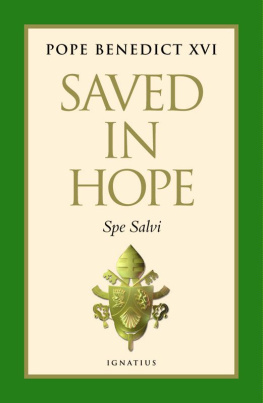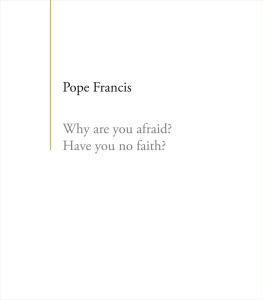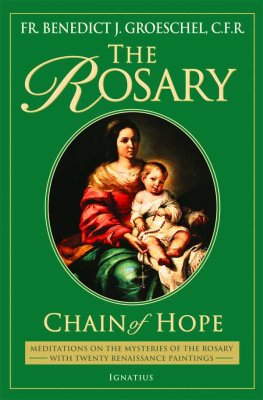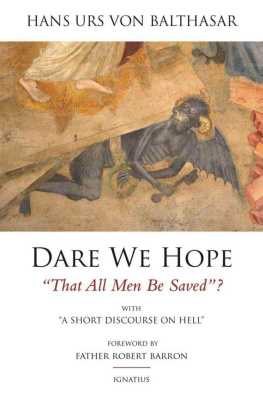SAVED IN HOPE
Spe Salvi
ENCYCLICAL LETTER
SAVED IN HOPE
Spe Salvi
OF THE SUPREME PONTIFF
BENEDICT XVI
TO THE BISHOPS
PRIESTS AND DEACONS
MEN AND WOMEN RELIGIOUS
AND ALL THE LAY FAITHFUL
ON CHRISTIAN LOVE
LIBRERIA EDITRICE VATICANA
IGNATIUS PRESS SAN FRANCISCO
Front cover art: Papal Coat of Arms of Pope Benedict XVI
by AgnusImages.com
Back cover photograph: Photograph of Pope Benedict XVI
by Stefano Spaziani
Cover design by Roxanne Mei Lum
Published in 2008 by Ignatius Press, San Francisco
2007 by Libreria Editrice Vaticana, Vatican City
All Rights Reserved
ISBN 978-1-58617-251-0
Library of Congress Control Number 2007938140
Printed in the United States of America
CONTENTS
I. Prayer as a school of hope
II. Action and suffering as settings for learning hope
III. Judgment as a setting for learning and practicing hope
Introduction
1. SPE SALVI facti sumus in hope we were saved, says Saint Paul to the Romans, and likewise to us ( Room 8:24). According to the Christian faith, redemptionsalvationis not simply a given. Redemption is offered to us in the sense that we have been given hope, trustworthy hope, by virtue of which we can face our present: the present, even if it is arduous, can be lived and accepted if it leads towards a goal, if we can be sure of this goal, and if this goal is great enough to justify the effort of the journey. Now the question immediately arises: what sort of hope could ever justify the statement that, on the basis of that hope and simply because it exists, we are redeemed? And what sort of certainty is involved here?
Faith is hope
2. Before turning our attention to these timely questions, we must listen a little more closely to the Bibles testimony on hope. Hope, in fact, is a key word in Biblical faithso much so that in several passages the words faith and hope seem interchangeable. Thus the Letter to the Hebrews closely links the fullness of faith (10:22) to the confession of our hope without wavering (10:23). Likewise, when the First Letter of Peter exhorts Christians to be always ready to give an answer concerning the logos the meaning and the reasonof their hope (cf. 3:15), hope is equivalent to faith. We see how decisively the self-understanding of the early Christians was shaped by their having received the gift of a trustworthy hope when we compare the Christian life with life prior to faith or with the situation of the followers of other religions. Paul reminds the Ephesians that before their encounter with Christ they were without hope and without God in the world ( Eph 2:12). Of course he knew they had had gods, he knew they had had a religion, but their gods had proved questionable, and no hope emerged from their contradictory myths. Notwithstanding their gods, they were without God and consequently found themselves in a dark world, facing a dark future. In nihil ab nihilo quam cito recedimus (How quickly we fall back from nothing to nothing): so says an epitaph of that period. In this phrase we see in no uncertain terms the point Paul was making. In the same vein he says to the Thessalonians: you must not grieve as others do who have no hope (1 Th 4:13). Here too we see as a distinguishing mark of Christians the fact that they have a future: it is not that they know the details of what awaits them, but they know in general terms that their life will not end in emptiness. Only when the future is certain as a positive reality does it become possible to live the present as well. So now we can say: Christianity was not only good newsthe communication of a hitherto unknown content. In our language we would say: the Christian message was not only informative but performative. That means: the Gospel is not merely a communication of things that can be knownit is one that makes things happen and is life-changing. The dark door of time, of the future, has been thrown open. The one who has hope lives differently; the one who hopes has been granted the gift of a new life.
3. Yet at this point a question arises: in what does this hope consist which, as hope, is redemption? The essence of the answer is given in the phrase from the Letter to the Ephesians quoted above: the Ephesians, before their encounter with Christ, were without hope because they were without God in the world. To come to know Godthe true Godmeans to receive hope. We who have always lived with the Christian concept of God, and have grown accustomed to it, have almost ceased to notice that we possess the hope that ensues from a real encounter with this God. The example of a saint of our time can to some degree help us understand what it means to have a real encounter with this God for the first time. I am thinking of the African Josephine Bakhita, canonized by Pope John Paul II. She was born around 1869she herself did not know the precise datein Darfur in Sudan. At the age of nine, she was kidnapped by slavetraders, beaten till she bled, and sold five times in the slave-markets of Sudan. Eventually she found herself working as a slave for the mother and the wife of a general, and there she was flogged every day till she bled; as a result of this she bore 144 scars throughout her life. Finally, in 1882, she was bought by an Italian merchant for the Italian consul Callisto Legnani, who returned to Italy as the Mahdists advanced. Here, after the terrifying masters who had owned her up to that point, Bakhita came to know a totally different kind of masterin Venetian dialect, which she was now learning, she used the name paron for the living God, the God of Jesus Christ. Up to that time she had known only masters who despised and maltreated her, or at best considered her a useful slave. Now, however, she heard that there is a paron above all masters, the Lord of all lords, and that this Lord is good, goodness in person. She came to know that this Lord even knew her, that he had created herthat he actually loved her. She too was loved, and by none other than the supreme Paron, before whom all other masters are themselves no more than lowly servants. She was known and loved, and she was awaited. What is more, this master had himself accepted the destiny of being flogged, and now he was waiting for her at the Fathers right hand. Now she had hopeno longer simply the modest hope of finding masters who would be less cruel, but the great hope: I am definitively loved, and whatever happens to meI am awaited by this Love. And so my life is good. Through the knowledge of this hope she was redeemed, no longer a slave, but a free child of God. She understood what Paul meant when he reminded the Ephesians that previously they were without hope and without God in the worldwithout hope because without God. Hence, when she was about to be taken back to Sudan, Bakhita refused; she did not wish to be separated again from her Paron. On 9 January 1890, she was baptized and confirmed and received her first Holy Communion from the hands of the Patriarch of Venice. On 8 December 1896, in Verona, she took her vows in the Congregation of the Canossian Sisters and from that time onwards, besides her work in the sacristy and in the porters lodge at the convent, she made several journeys around Italy in order to promote the missions: the liberation that she had received through her encounter with the God of Jesus Christ, she felt she had to extend, it had to be handed on to others, to the greatest possible number of people. The hope born in her which had redeemed her she could not keep to herself; this hope had to reach many, to reach everybody.
The concept of faith-based hope in the New Testament and the early Church










